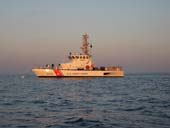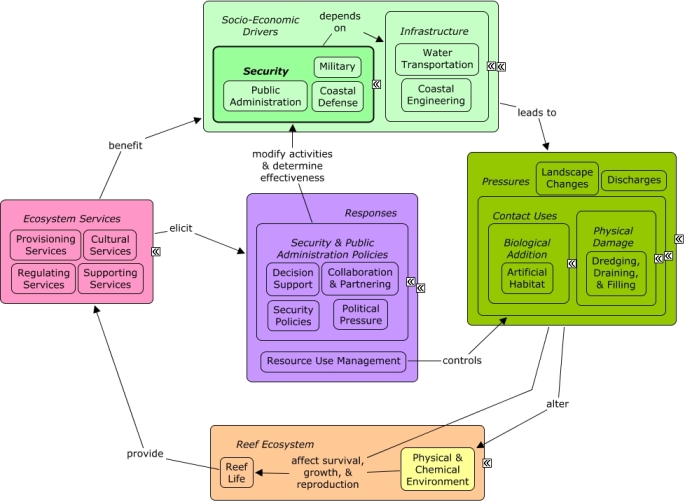ReefLink Database

Military
The Military is authorized by the government to use force in order to defend its country, and includes the Army, Navy, Air Force, and Marine Corps, as well as organizations involved in the manufacturing and supply of military equipment.
CMap

CMap Description
Coastal defense is dependent on large ships that may require dredging of reefs or coastal vegetation to enable transportation into ports. In some areas, such as Vieques, Puerto Rico, Armed Forces training exercises have left discarded ammunition in coastal areas that may provide artificial habitat or discharge contaminants into coastal waters. Security sectors benefit indirectly from ecosystem services that improve the well-being of other sectors, such as culture or fishing, which pressure public administration to enact responses to protect reef ecosystems. Public administrators may improve decision-making through collaboration & partnering, and may improve effectiveness of regulations through law enforcement.Citations
More than 50 citations. Click here to load.
| Citation | Year | Study Location | Study Type | Database Topics |
|---|
Management Options
| Management Option | Description | Sources | Database Topics |
|---|---|---|---|
| Damage Assessment, Documentation & Response: Respond to Natural Resource Injuries form Derelict Vessels | Semi- permanent/permanent vessels can have a negative impact on the surrounding local environment both due to the effects of shade and from the direct contact with the substrate. Sunken vessels that cannot be seen from the surface may present a danger to navigation. Derelict vessels that do not remain stationary may cause harm in multiple locations before becoming stationary. If fishing gear is still intact, it may cause further biological damage through "ghost fishing� (#283). Early response, creating mooring fields, pump-out stations, and providing support for removing derelict vessels, reduces the impact of these vessels. Also, the removal of intrusive vessels will help contribute to the restoration of reef areas to previous conditions. | NOAA Marine Sanctuary Program. 2007. Florida Keys National Marine Sanctuary revised management plan. National Ocean Service, Key West, FL. |
Anchoring & Vessel Grounding; Artificial Habitat; Artisanal Fishing; Biological Monitoring & Restoration; Boat Movement; Boating Activities; Boating Regulations; Coastal Defense; Commercial Fishing Boats; Coral; Ecosystem Monitoring & Restoration; Environmental Monitoring & Restoration; Large Ships; Marine Debris; Military; Physical Damage; Reef Habitat; Reef Life; Resource Use Management; Seagrasses; Small Boats; Stony Coral; Substrate; Transportation Policies; Water Depth & Sea Level; Water Transportation; Wetlands |
| Damage Assessment, Documentation & Response: Collaborate with Towing & Salvage Operators in Grounding Notification | This option advocates the establishment of rapport between local operators and regulatory agencies. This is achieved through regular meetings and training sessions to emphasize the importance of operator cooperation in regards to vessel groundings. | NOAA Marine Sanctuary Program. 2007. Florida Keys National Marine Sanctuary revised management plan. National Ocean Service, Key West, FL. |
Anchoring & Vessel Grounding; Boating Activities; Coastal Defense; Collaboration & Partnering; Commercial Fishing Boats; Cruise Ships; Cultural Policies; Environmental Education & Outreach; Large Ships; Military; Oil & Gas Tankers; Physical Damage; Security & Public Administration Policies; Small Boats; Transportation; Transportation Policies; Water Transportation |
| Monitor & Research: Monitor Use Patterns on Artificial and Natural Reefs | This management option seeks to provide data for decisions concerning creating new artificial reefs. Use data is important because justification for artificial reefs extends from their ability to shift use pressures (diving, fishing, etc.) from natural reefs. Once an artificial reef is decided on there is much more data to collect and factors to consider when deciding where the artificial reef (#189). | NOAA Marine Sanctuary Program. 2007. Florida Keys National Marine Sanctuary revised management plan. National Ocean Service, Key West, FL. |
Artificial Habitat; Biological Addition; Biological Monitoring & Restoration; Boating Activities; Civil Engineering & Construction; Coastal Defense; Complex Habitat & Resources; Coral; Cultural Services; Decision Support; Dive, Snorkeling, & Swimming Tourism; Ecosystem Monitoring & Restoration; Environmental Monitoring & Restoration; Finfish & Shellfish Stock; Fishing Sector; Military; Museums, Amusement Parks, Historical Sites; Provisioning Services; Recreational Fishing; Recreational Opportunities; Reef Habitat; Reef Life; Security; Security & Public Administration Policies; Supporting Services; Tourism & Recreation; Tourism & Recreation Policies; Transportation; Travel Services & Tour Operators; Valuation; Wetland & Reef Restoration |
| Restoration: Environmental Remediation | Environmental Remediation is a type of restoration that's focus ranges from Brownfields to Oil Spills to Hazardous Waste Sites. These restoration activities aim to restore the site to a previous condition, or to a condition that is not a threat to human health or other forms of life. Several standards can be used to determine when remediation is necessary and to what extent the environment should be restores. Biocriteria can be used to determine the degree of degradation to biological components of the site. Often it is the presence of a particular pollutant in the soil, water or air, which is above acceptable limits and will not degrade fast enough over a short period of time and therefore must be removed. Physical and chemical water quality criteria can be used to set maximum acceptable limits of water quality parameters. Air quality criteria can be used to set acceptable maximum and minimum air standards for remediation. | Office of Solid Waste and Emergency Response. 2005. Contaminated Sediment Remediation Guidance for Hazardous Waste Sites. EPA-540-R-05-012, US Environmental Protection Agency. Environment Protection Authority. EPA Guidelines for Environmental management of on-site remediation. Environment Protection Authority, Adelaide, Australia. |
Applied Chemicals; Biocriteria; City Planning; Decision Support; Discharge Limitations; Discharges; Ecosystem Monitoring & Restoration; Environmental Monitoring & Restoration; Environmental Monitoring, Mapping, & Scientific Research; Food, Beverage, & Tobacco Products; Health; Health Policies; Landuse Management; Littering; Manufacturing & Trade; Metals, Electronics, & Machinery Products; Military; Mining; Mining Policies; Mitigation; Monetary Valuation; Nutrient & Contaminant Processing; Oil & Gas Industry; Oil & Gas Rigs; Oil & Gas Tankers; Petroleum Spills; Physical & Chemical Water Quality Criteria; Pipelines; Point Source Discharges; Public Administration; Remediation; Security; Solid Waste Disposal; Supporting Services; Toxics; Valuation; Waste Management; Waste Management Policies; Wastewater Discharge; Waterborne Discharges; Wood, Plastics, & Chemical Products |
Laws
| Legal Citation | Purpose of Law | Management Organization | Database Topics |
|---|
